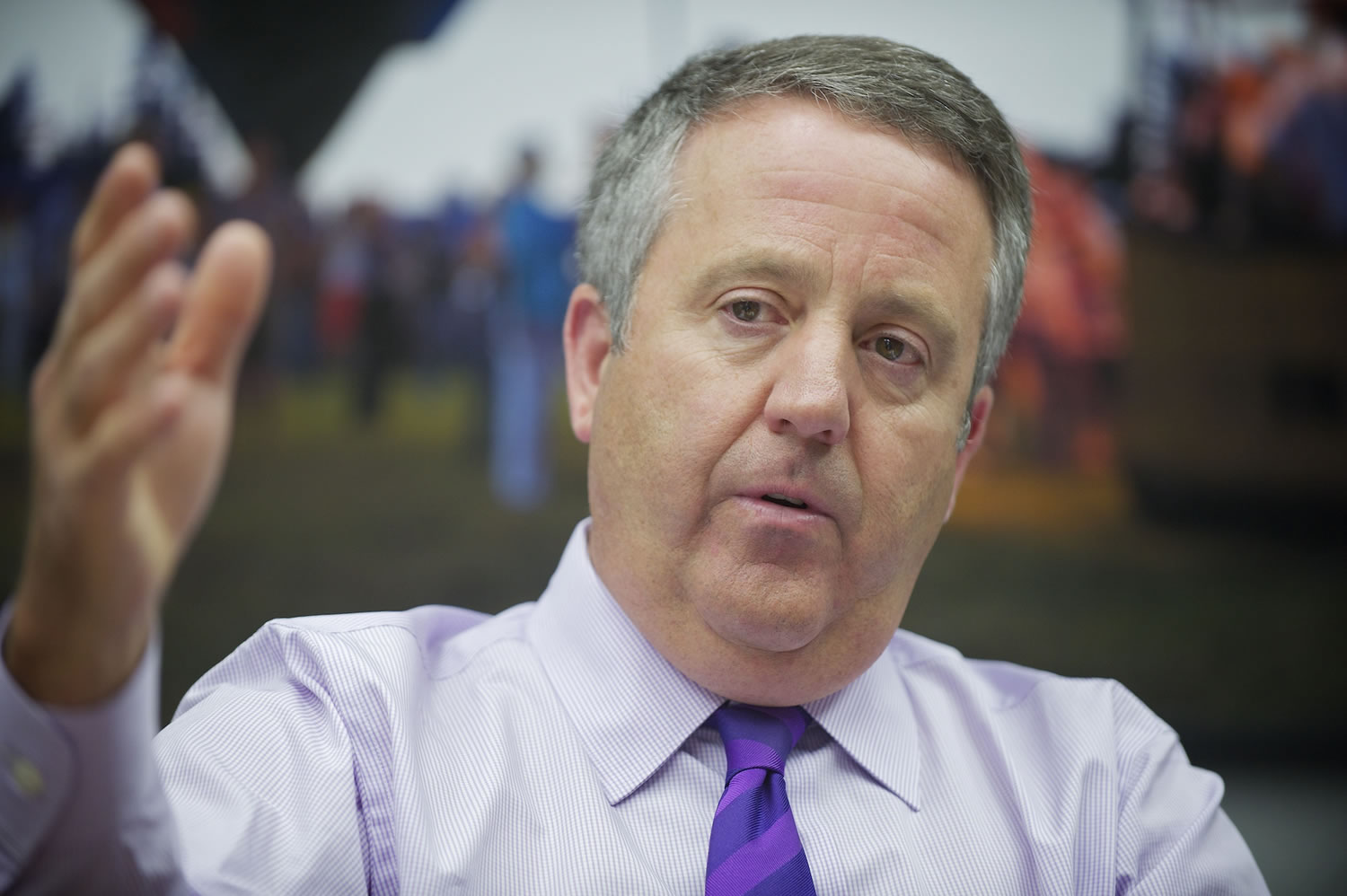BNSF Railway Chairman and CEO Matthew Rose weighed in Thursday on his company’s involvement in controversial plans to export coal from the Pacific Northwest, saying some of the concerns are overblown and that fewer export terminals will be built than the five now proposed in Washington and Oregon.
“We owe you as a community more information,” Rose said of his swing through Washington this week. He visited The Columbian’s office in Vancouver between appointments in Spokane, Bellingham and Seattle.
Those cities are among many in Washington and Oregon that have expressed worries about proposals to build coal-export terminals in both states for shipment to Asia. Their concerns include everything from increased coal-train traffic and coal dust to an upsurge in carbon dioxide and particulate emissions in energy-hungry countries such as China.
Rose has led Fort Worth, Texas-based BNSF Railway since 2000. His boss is billionaire investor Warren Buffett, who acquired the railroad in 2010 through his Berkshire Hathaway Inc. The railroad already makes billions of dollars annually in coal transport, mostly in the eastern United States, and stands to earn more if coal shipments to Asia are expanded.
Rose said there’s been “widespread speculation” about the potential increase in coal-train traffic through the Pacific Northwest driven by proposals to construct coal-export operations. Some estimates have pinned the traffic increase at 60 to 100 trains a day, he said, but, “I promise you, that’s nowhere in the realm of seriousness. It’s not realistic.”
‘That’s a real issue’
For one thing, Rose said, one of the six proposed coal terminals that were initially proposed has been shelved. It would have exported as much as 5 million tons of coal a year from the Port of Grays Harbor to Asia.
What’s more, Rose said, he doesn’t expect all of the other proposed terminals to be built. “Five facilities, I do not believe will ever be built,” he said. “The market will sort that out.”
What’s likelier is that the market will support the development of two, “maybe three,” coal terminals, Rose said.
That would put the total amount of potential coal exports from the Pacific Northwest at roughly 50 million to 100 million tons annually, he said. Some estimates had pegged it at 150 million tons or more annually.
As a result, Rose said, he expects there would be an additional eight to 12 coal-hauling trains — maybe 12 to 16 — running through the Columbia River Gorge to export facilities in the Northwest each day. The coal would arrive by rail, or rail and barge, from the Powder River Basin in Montana and Wyoming.
“That’s a real issue,” Rose said of those additional trains. “We don’t deny that eight trains a day or 10 trains a day is going to be an issue.”
Rose said train traffic in Clark County would be affected by proposed coal terminals in Whatcom and Cowlitz counties. He estimated the projects would add six to 10 coal-bearing trains to rails running through the area.
Currently, about three to four coal trains a day pass through Clark County.
As to the issue of increased train traffic’s creating transportation chokepoints, Rose said BNSF understands those issues, including the concerns of emergency responders, and would be part of any solutions.
The railroad would help the cities “work through that,” he said.
One key concern is the question of what happens when a coal train derails, Laura Stevens, a Portland-based representative of the Sierra Club’s “Beyond Coal” campaign, said in a phone interview. A slew of recent accidents, in some cases fatal, have grabbed headlines and fueled the regional debate on coal exports. They force local communities to devote their resources to emergency response and cleanup, and should be addressed before increased rail traffic drives up the risk of such incidents, Stevens said.
“At this point, I think we need to find out what the plan is, and if there is a plan,” Stevens said. “It’s unfair for these communities to have to bear the costs of these projects.”
Alliance backs coal exports
Backers of bringing coal to proposed export terminals in Washington and Oregon say the operations will generate thousands of new jobs and boost the economy.
BNSF Railway is a member of a chief proponent of those plans — the Alliance for Northwest Jobs and Exports, whose membership also includes global energy companies, trade associations and unions. The group launched a media campaign last month to support plans to export coal from West Coast sites.
It has squared off against environmental groups and community activists who say the negative impacts to human health and the planet are too enormous to allow more coal exports.
And opponents of coal export terminals say they don’t plan to sit idly, waiting for the market to decide whether — or how many — coal terminals get built. Each of the proposals currently on the table is being pursued by a different company — and all of them want to see their facility happen, said Stevens, the Sierra Club representative. “We certainly hope that none of them will go through,” she said.
Coal loads sprayed
During his visit to The Columbian, Rose also addressed concerns about increases in coal dust from the additional train traffic. He said BNSF is “deeply committed” to spraying coal loads with what’s known as a surfactant — a protective spray — to keep dust tamped down.
“It kind of binds it,” he said of the spray.
Another environmental concern is increased pollution from locomotives transporting the coal. The cumulative diesel emissions produced by all current train and barge traffic already ranks them among the top polluters in Southwest Washington.
BNSF Railway plans to spend $1.1 billion on energy-efficient, low-emission trains that cut nitrogen oxide by 60 percent and particulate matter by 69 percent.
Rose said it’s difficult to say whether any of those cleaner-burning locomotives would end up in Southwest Washington, including Clark County, since there are a variety of factors that influence how and where the railroad upgrades its fleet and maintains older locomotives.
“We know that each state wants us” to put the cleaner-burning locomotives in their communities, Rose said.
Some of the environmental concerns raised by critics of coal-export plans aren’t local — they’re global. They point to scientists who’ve said the earth’s air has reached dangerous new levels of carbon dioxide — the main climate-change pollutant — because of the burning of fossil fuels such as coal and oil.
Asked to respond to concerns about the climate-change impact of feeding more coal-fired power plants, Rose said: “I don’t address climate change, because I’m not qualified to.”
‘The right balance’
What he understands, Rose said, is that developing nations want low-cost energy — just as the United States did when it was industrializing — and coal will play a sizable role in slaking those countries’ thirst.
Even if coal-export terminals never happen in the Pacific Northwest, he said, “the worldwide demand for coal will not go down one — one ton.”
Given the state of the U.S. economy — and the Obama administration’s call for the nation to double its exports — Rose said, it’s important for the country to serve the energy demands of the developing world, including shipping coal.
BNSF derives about a quarter of its $20 billion in annual revenues from the coal business. “Coal is a big business for us, without a doubt,” Rose said. “And quite frankly, it always has been.”
More than 10 percent of the electricity produced in the U.S. is generated from coal hauled by BNSF, according to the railroad’s figures. And more than 90 percent of the coal BNSF transports comes from the Powder River Basin in Montana and Wyoming.
Stevens, the Sierra Club representative, said opposition efforts have mainly targeted coal companies themselves, not the railroads that would carry their product. Stevens said a key goal is ensuring a robust review process — which many local and regional leaders have also called for — and putting the debate out in the open. BNSF and Union Pacific are something of a “middleman” in the ultimate equation, she said.
Rose said layers of environmental review also can morph into a way to stop a project, regardless of its merits. He said a BNSF project in Southern California has been waiting for seven years for permits to be issued.
“There’s not a lot of things that are easy to build in this country,” he said. “And these (coal facilities) are a great example of that.” Rose said Oregon Gov. John Kitzhaber’s call for a “programmatic” environmental review of the coal-export proposals — a more global, as opposed to local or regional, examination — is an example of an attempt to bog down the process. Rose said it would be a “killer” of the coal-export plans.
He said the environmental review process in the U.S. is necessary and that the country “is much better for it.”
However, he added, “at the end of the day, we have to find the right balance in all this.”




